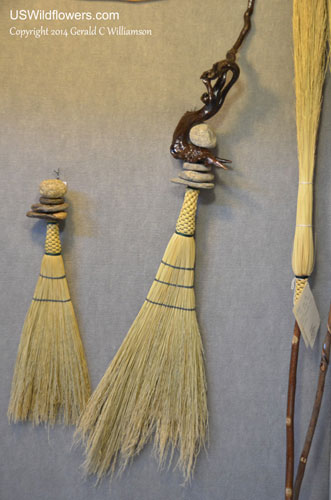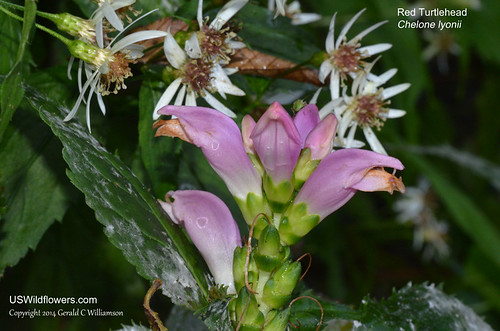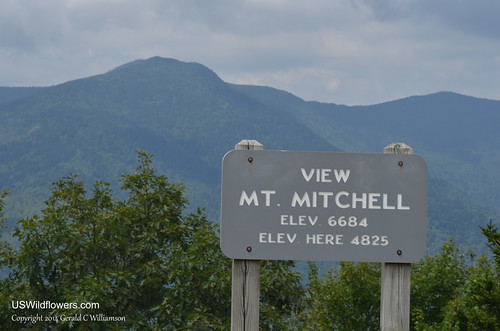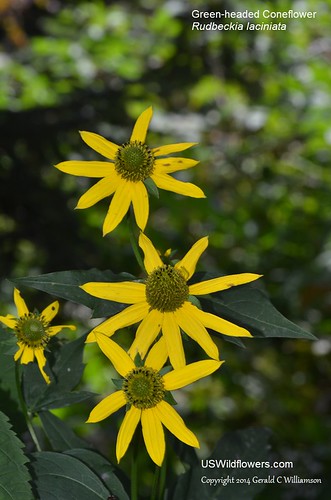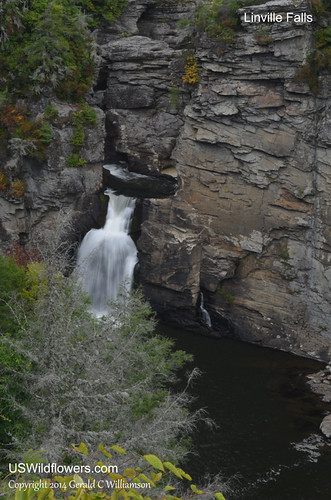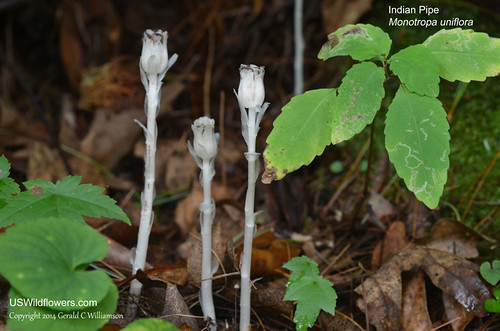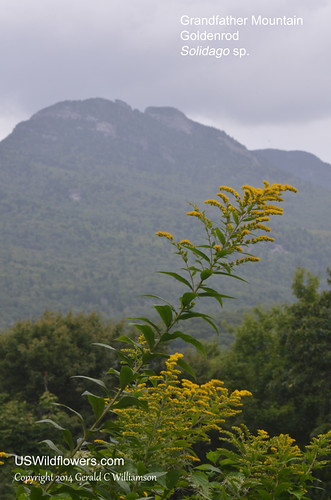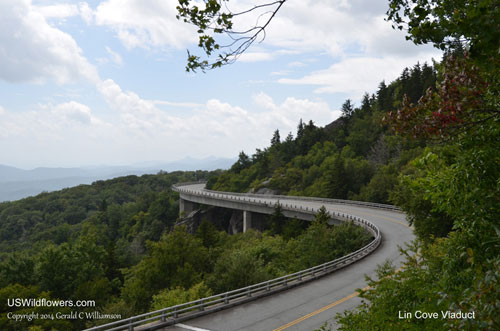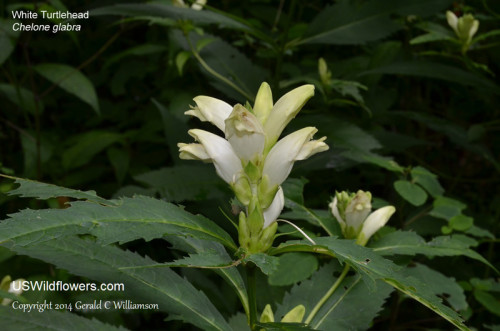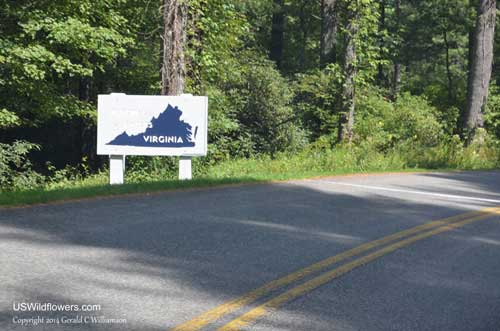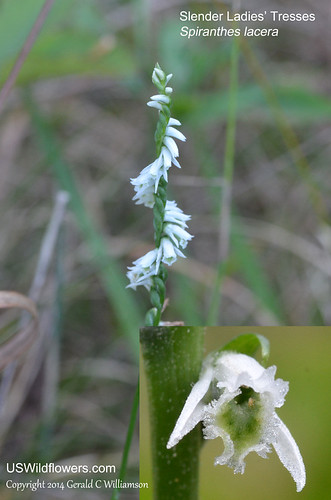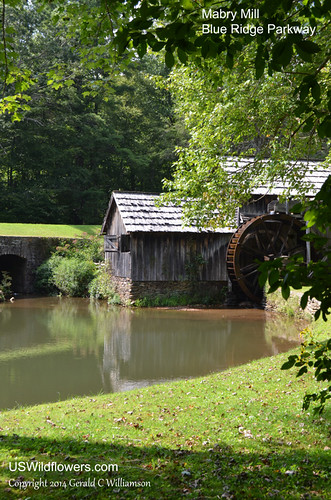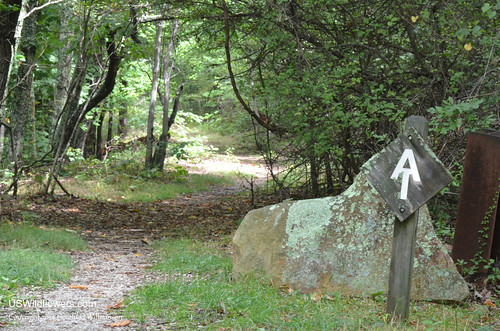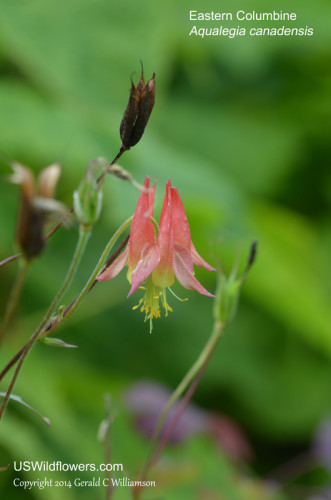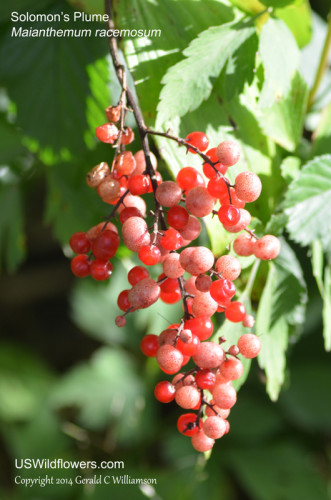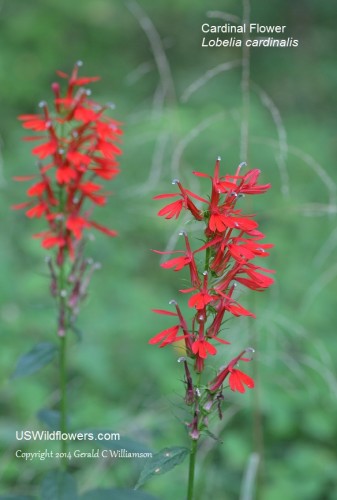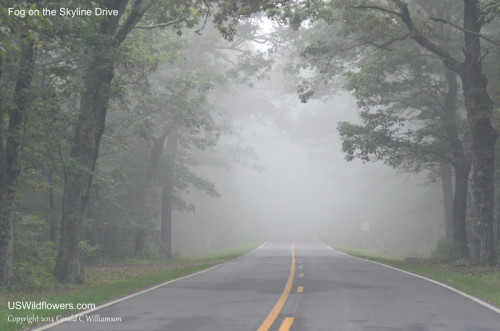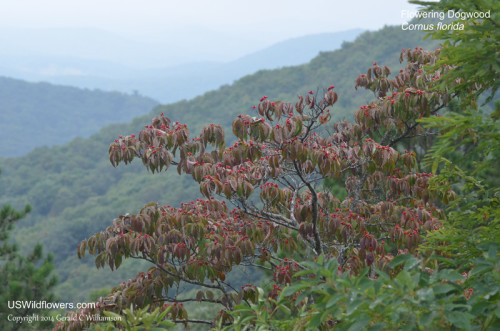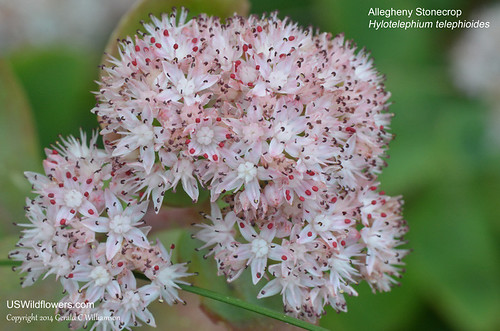My wife and I were heading to a couple of events in Morganton (a memorial service) and Linville (a wedding), NC on Labor Day weekend. We have family in Roanoke, VA, and we had some spare time after the wedding, so we decided to drive the Blue Ridge Parkway, which runs by Linville, and on our return trip to stop by Roanoke for a visit afterwards.

One of the wildflowers that stayed with us from end to end was Spotted Jewelweed – Impatiens capensis – along with its sister, Pale Touch-me-not – Impatiens pallida
We had planned on starting early on Thursday, Aug 28, to be able to drive the GSMNP-to-Asheville section of the Parkway, but another commitment took Thursday morning, so we skipped that part of the Parkway, and drove straight to Asheville, where we had a nice dinner at Village Wayside in Biltmore Village. A night in a nearby hotel left us staged for our first day of Blue Ridge Parkway on Friday, Aug 29. Only a few miles after heading north on the Parkway we made our first stop at the Folk Art Center operated by the Southern Highland Craft Guild.
I’m not a museum kind of guy, so I wasn’t expecting to want to spend much time here, but I was surprised by my reaction. I was emotionally moved by the beauty and craftsmanship of the works of the artists on display (and for sale) at the Folk Art Center. Not only are there static displays, there is an active exhibit of craft-making going on, although we were too early to watch the broom-making going on, the current active exhibit. However, the artist Marlow Gates of Friendswood Brooms was setting up, and while photography is generally forbidden within the Folk Art Center (protecting the intellectual property of the artists), Mr. Gates kindly gave me permission to photograph his brooms. Their brooms are “made by hand using techniques that date to the 1790s.”
As we started heading up the Parkway again I was amazed at the display of wildflowers – please understand that what I talk about and show here is just a fraction of the wildflower species we saw on this trip. Spotted Jewelweed, Pale Touch-me-not, various sunflowers, White Snakeroot, Blackeyed Susans, and Joe Pye Weed were everywhere. Naturally butterflies were enjoying the flowers as much as we were. Craggy Gardens picnic area was another great stop where we found many wildflowers, both along the access road and around the picnic grounds.
Our next major stop after Craggy Gardens was the Mt. Mitchell State Park, on a side-spur of the Blue Ridge Parkway.
They have a restaurant in the park with GREAT views where we stopped for lunch, and then we drove up to the top for more great views before heading north again, this time in something of a hurry to make sure we could get to the Friday evening beginning of our weekend commitments.
On Monday, the first day of September, after our weekend of festivities, we headed out to the Blue Ridge Parkway, first heading south from Linville to visit Linville Falls. The walk to the falls was pleasant and not difficult, and there were quite a few wildflowers along the trail. But naturally the sight to see is the falls themselves.
We then headed north again, with our next major waypoint being the famous Lin Cove Viaduct which runs along the slope of Grandfather Mountain.
The Lin Cove Viaduct is an S-curved 1200-foot bridge which was the final part of the Blue Ridge Parkway to be completed. It was finished about 10 years after the completion of the rest of the Parkway, the delay due to the environmentally sensitive area through which it is routed. Starting at the Lin Cove Visitor Center, a moderately strenuous hike will take you to a rock overlooking the viaduct for the famous view seen in many photos.
However, the walk along the first part of that trail is paved and easy, and goes through the environmentally sensitive area under the viaduct, which on the first of September was lined with many wildflowers, including a couple of “lifers” for me – White Turtleheads and Beechdrops.
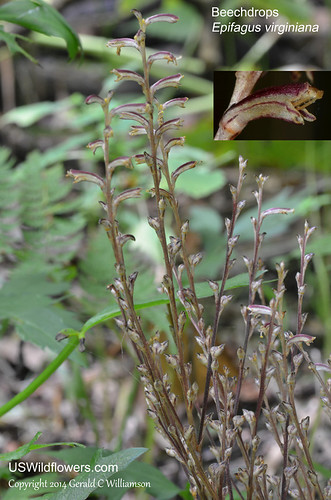
Epifagus virginiana – under the Lin Cove Viaduct” class /> Beechdrops – Epifagus virginiana – under the Lin Cove Viaduct
Here it was afternoon and we’d only come less than 10 miles north on the Parkway. We lunched in the Lin Cove parking lot, and headed onward, unable to resist stopping every few minutes. As well as many overlooks, we stopped at the Moses Cone Mansion, and then approaching Boone’s Trace overlook, I noticed a yellow flower along the road much different from those we’d been seeing. A road-turn on the Blue Ridge Parkway is a lot easier than on other roads, so we quickly turned around and found that the yellow flower was a lifer for us, and a reminder that invasives have a reach even into “remote” areas – it was Butter and Eggs, an introduction from Europe.
A few hours and several more stops had us at our end of the day, and we descended from the Blue Ridge Parkway down to Sparta, NC to spend the night. We found reasonable accommodations at the Allegheny Inn and Conference Center. After breakfast at J B’s Pizza & Subs (yes, breakfast at a pizza place – it was good) we drove the 7 miles back to the Parkway and once again headed north. Even though we were at somewhat lower elevations as we passed into Virginia, the temperature stayed in the 70’s (as they did the whole trip, except for the brief drop to the James River on our final day on the Blue Ridge Parkway), and we continued to drive with the windows down. Turned out this was ill-advised, since along with all the beautiful fall wildflowers blooming, ragweed was also at its peak, and it started to take a toll on my wife – she’s still recovering days after ending the Parkway trip.
But it was beautiful, and we took full advantage of it on day 3 on the Parkway. Cumberland Knob was one of our stops, with a very interesting history of the Parkway provided there, a worthwhile stop before passing into Virginia.
We stopped for something on the roadside about 10 miles into Virginia and my wife noticed a white flower hidden in the grass. It was another “lifer” for us – Slender Ladies’ Tresses, an orchid with a spiraling inflorescence. This species is differentiated from some similar species in the genus by the green markings on the interior of the flower.
We had the Folk Art Center, Craggy Gardens, and Mt. Mitchell on day 1 – three major stops; Lin Cove and Linville Falls on day 2 – two major stops, but on our 3rd day of driving the Blue Ridge Parkway we only had one “major” stop – Mabry Mill. We had been here before, but enjoyed it again.
Since we didn’t have as many long stops, we traveled about 110 miles of the Parkway on the 3rd day, and spent the night in south Roanoke. While we were close to our relatives in Roanoke that evening, it was late and Cindy was feeling the impact of the days with the windows down – remember the mention of the ragweed – so we just holed up in an inexpensive hotel for the night, eating peanut butter and jelly sandwiches from our lunch larder.
On our 4th and final day on the Blue Ridge Parkway we targeted completing the remaining 120 miles. As we drove up Roanoke Mountain for a quick drive-by of the Virginia’s Explore Park I started to wonder if we’d make that – another beautiful day implied many stops at overlooks and interesting spots. Among the interesting finds were the American Chestnuts (pretty sure that’s what they are) at a few of the overlooks.
Among the many wildflowers that I’ve now seen at both the southern end and northern end of the Blue Ridge Parkway are the tiny Harebells, one of my wife’s favorites.
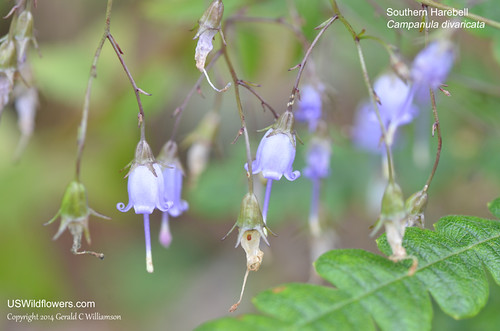
Southern Harebell – Campanula divaricata
The Parkway, which had left National Forests behind at the NC border, runs instead through high mountain farmlands from North Carolina to Roanoke. As it heads north of Roanoke, however, it returns to National Forests, running first through Jefferson National Forest, and then crossing the James River leaves Jefferson and enters the George Washington National Forest. The Appalachian Trail swings eastward to cross through Roanoke and first crosses the Parkway around mile 100, shortly after entering the Jefferson National Forest. The AT then fairly closely follows the Parkway all the way to its northern end, where it ascends into the Shenandoah National Park, and the Blue Ridge Parkway makes way for the Skyline Drive, which does the same.
But along the way through the Jefferson National Forest the mountain views and wildflowers continue. We stopped to photograph a patch of beautiful Great Blue Lobelia, and discovered while doing so that we were not the only ones in the forest enjoying the butterflies.
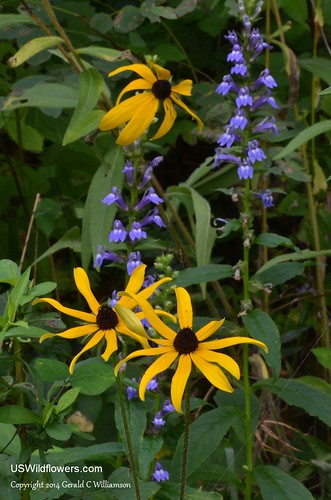
Blackeyed Susan – Rudbeckia hirta – and Great Blue Lobelia – Lobelia siphilitica
Fall wildflowers are beautiful, and we weren’t surprised to see some summer wildflowers hanging on – like the Harebell shown previously. But we were caught by surprise to discover that spring was still hanging on to the western side of the Blue Ridge – these Columbine were blooming!
Definitely reflecting a later season than spring was a patch of both Solomon’s Seal and Solomon’s Plume bearing their berries. Solomon’s Plume berries are the more obvious and colorful of the two.
At the Solomon’s Plume site there was also an interesting pine tree overlooking the Shenandoah Valley.
After enjoying the overlook with the pine tree we descended to Humpback Rocks Visitor Center, where some Cardinal Flower was blooming – we’d seen this off and on at various wet areas along the Parkway, but here it was easy to get close to them in a moist area near the parking lot.
We finished the remaining few miles of the Parkway and went down to Waynesboro where we spent the night in a nicer hotel than is our usual fare, but we were tired and looked forward to more luxurious accommodations. The next day, before driving to Roanoke for an excellent visit with family, we drove part of the Skyline Drive. While this is a Blue Ridge Parkway report, you’ll get a “bonus” of a few photos from that first 30 miles of the Skyline Drive. As we drove toward the mountains, we could see clouds clinging to the ridgeline. It was quite foggy for the first hour after we stopped at the entrance gate and showed our America the Beautiful pass to get our free admission into the Shenandoah Park (normally $15 for a car.)
I haven’t mentioned fall colors so far, but they definitely were starting. There were hints and splashes of red and yellow, and by the northern end of our drive, the colors were beginning to be obvious.
I want to close with another “lifer” wildflower for me – one we had seen in the rock outcroppings of the northern end of the Blue Ridge Parkway, but didn’t find where we could park and photograph until we got into Shenandoah National Park. So here’s the closing photo – Allegheny Stonecrop.


